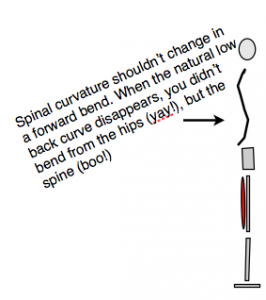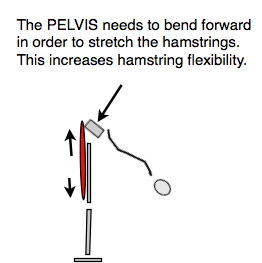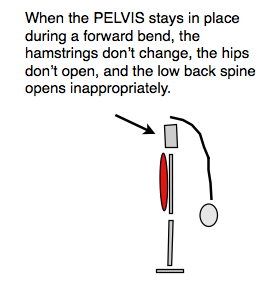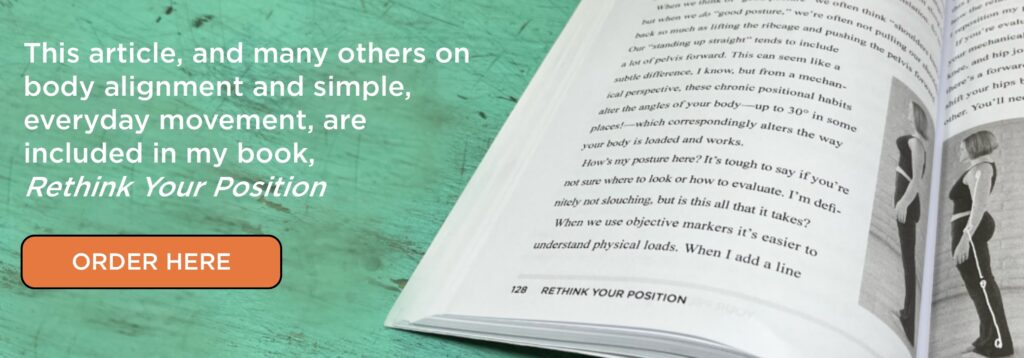This article was updated Feb 2020 to make it bettah. For a lot more on how hamstrings impact whole-body and pelvic health, read Our Best "Healthy Pelvis" Resources.
Let's start with some quick hamstring anatomy tidbits:
1. The hamstrings are comprised of three separate muscles: Biceps femoris, semimembranosis, and the semitendinosis.
2. The hamstring group is biarticular, meaning they pass over two joints. In the case of the hamstrings, they pass over both the hip and the knee joint, which means they connect the pelvis to the shins.
3. If flexible enough, the hamstring group allows the pelvis, thigh, and lower leg to be positioned in “neutral” (pictured below). If not, they can tuck the pelvis and bend the knee while standing. 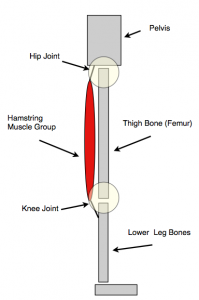
4. The hamstrings are commonly listed in textbooks as knee flexors (muscles that bend the knee) but this muscle group is used more often as a hip extensor (muscles that pull the thigh backward relative to the pelvis), when walking. As we become more dynamic as a people I wager our books will more thoroughly explain the way our bodies move.
5. The backward motion of hip extension is the primary (most efficient) motion used to propel the body forward when walking (think of an ice skater pushing back against the ice to move forward—more on this in the gait chapter of Move Your DNA), but through our adaptations to modern environments and very little movement, gait patterns have sort of reversed. Often we're just lifting a leg in front of us and falling forward. Ow.
6. Sitting and/or chronic pelvis tucking move the hamstring muscles’ attachment sites toward each other, shortening the muscle (see picture below). Do this a lot and they tighten in this shape. 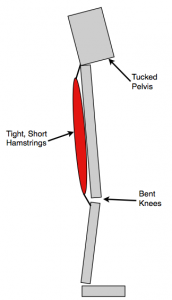
7. When the hamstrings are really (really) tight, they can prevent the knees from straightening or the pelvis from untucking. I write a lot about the pelvis and pelvic floor issues and often overlooked is how the hamstrings impact the mechanics of this area. This is why hamstring and hip movements need to be part of a robust, healthy pelvic floor program.
8. Tight hamstrings affect the articulating surfaces of the knees and hips and you can get too much rubbing in one spot. When I think of rubbing, I think of heat and inflammation and about cells in my joint cartilage.
Why are the hamstrings so tight?
There's likely a hundred different unique situations that can affect human tissue, but we can start with the four reasons listed here:
1. We sit a billion hours a day (we practice hours of hamstring-shortening movement).
2. Many tuck their pelvis because they've been told to (good posture, better manners, etc.).
3. Our shoes have almost always had a positive heel, which requires the knees bend or pelvis tuck to adjust to the decline geometry underfoot, which shorten the hamstrings.
4. We don't move very much at all, so these muscles don't learn how to do much work.
And now, what you've all been waiting for...
How to stretch your hamstrings
If you want to change the length of your hamstrings you have to move them more and when you do specific hamstring stretches, you want to make sure that you're moving the attachments away from each other—not moving both of them in the same direction.
To move hamstring attachments away from each other, don't bend your knees while stretching. Bending your knees moves the attachments back towards each other.
Similarly, don't tuck the pelvis while stretching your hamstrings. Tucking your pelvis moves the attachments back towards each other.
You don't have to do giant and hard stretches, just start by holding the leg with a strap (as pictured below) and straighten the knee and untuck the pelvis. Don't start with your leg high—this makes straightening the knee and moving the pelvis more difficult. Keep the leg low and practice moving the hamstring attachments away from each other.
Strap Stretch from our Movement Multivitamin and what to watch for (click on the picture to blow it up):
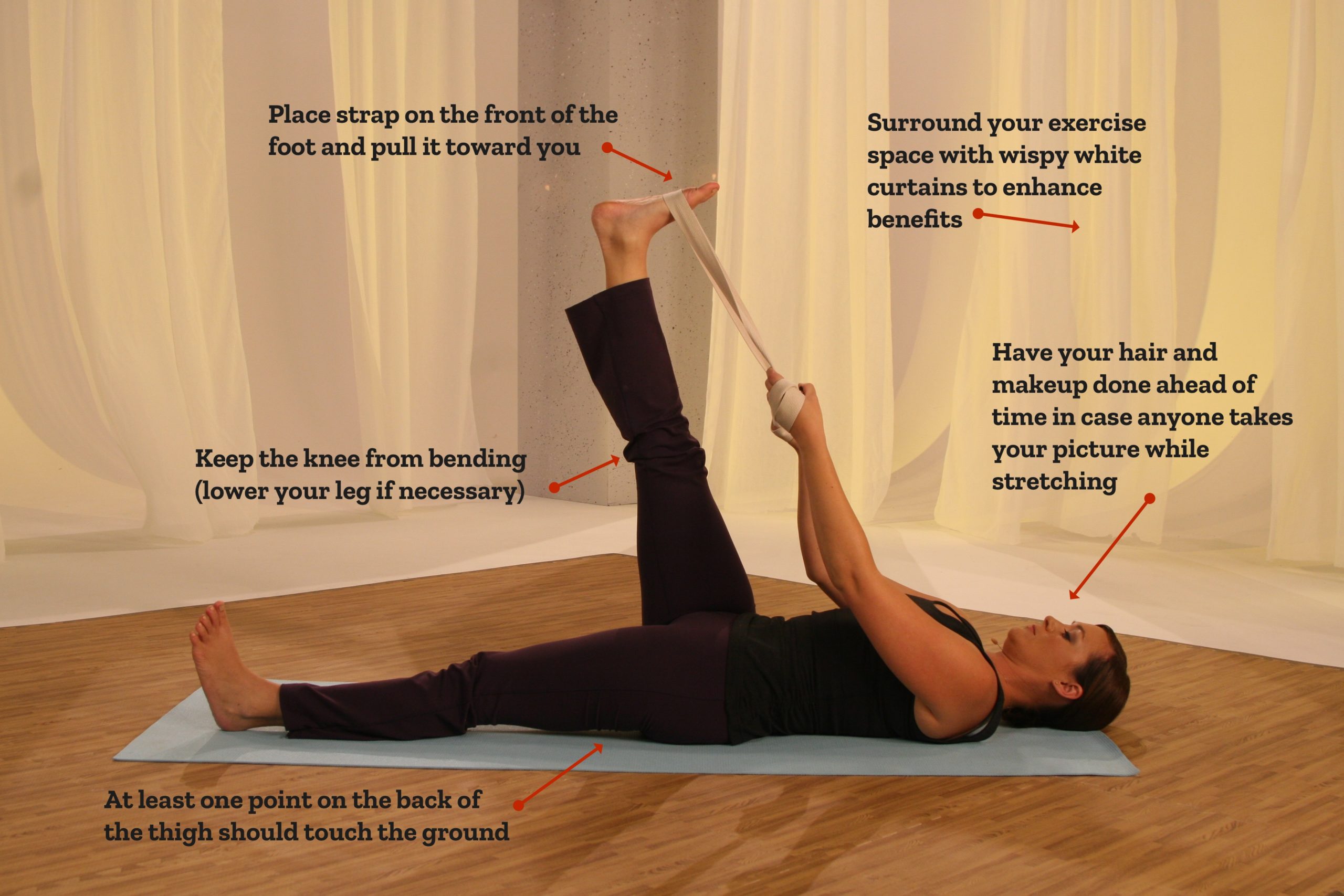
Because the muscle passes over the knee and hip joint, moving the pelvis or changing the knee joint angle during Strap Stretch keeps the hamstrings the same old length as when you started.
When we go to, say, a yoga class, we often want to move our limbs as high or as far as we can, but in the case of this move, you'll see the bottom leg lift away from the ground—a sign the pelvis has tucked. Try this: place a hand towel under the back of the thigh on the ground, and make sure you or your alignment buddy can’t pull it out as you're stretching your top leg. You may find that you need to lower the stretching leg almost all the way to the floor to move your hamstring well.
Forward Bends: Flexibility vs. Mobility
Forward bends should help the user find the hamstrings, but more often I find folks reach the floor by bending forward more from from the spine and knees and not from the hips. Here is my best attempt at drawing the difference...
Moral of the forward-bend story is this; to move your hamstrings via a forward bend, keep the knees straight and stop traveling forward once the pelvis stops moving forward.
Common question: Should I bend my knees to go farther then?
Common Katy Answer: It depends on why you're doing your forward bends. If you bend your knees, then 1) you’re not stretching your hamstrings and 2) you are making your low back hold the load of your upper body. If you are using forward bends to improve muscle length and strength, then it is better to stay within your range of motion—even if it means you lose the beautiful sweeping motions you used to do in class. Adjust your forward bends to ones that mindfully honor your current muscle boundaries. You will make much more progress when it comes to changing your parts. There are also many other reasons for a forward bend and maybe moving your hamstrings isn't your goal; in that case bend in the way that suits your bending-purpose.
Let’s hear it for some lukewarm graphic artistry skills! {crowd responds with a loud cheer!} My favorite is the squiggly spinal column.


